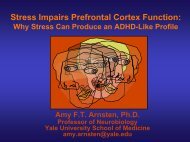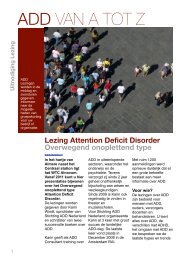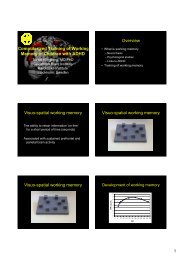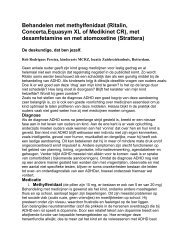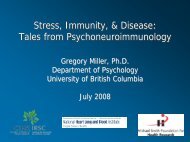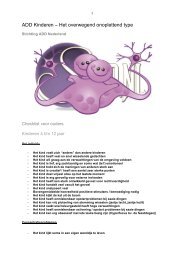Linda Mayes: Attachment and Emerging Stress-Reward System ...
Linda Mayes: Attachment and Emerging Stress-Reward System ...
Linda Mayes: Attachment and Emerging Stress-Reward System ...
You also want an ePaper? Increase the reach of your titles
YUMPU automatically turns print PDFs into web optimized ePapers that Google loves.
Links Across the Conference• Neurocircuitry of reward <strong>and</strong> stress systems(Weinberg & Krebs)• Long term impact of chronic stress (McEwan(McEwan)• How acute stress impacts prefrontal fx (Arnsten)• How social cues such as faces may elicitfear/stress (Walden)
Roots of Questions• Studies of earlyadversity <strong>and</strong> impact onemotional development• Prenatal drug use• Family PovertyIndividual developmental pathways• Meaning ofbehavior• Motivation• Relationships
Outline—Part 1• Basic propositions about early attachment• Relationship between stress, reward, <strong>and</strong>attachment• Special parenting minidset of earlypreoccupation• “Biology” of Parenting--oxytocin• Neural circuitry of parent-infant attachment
Outline—Part 2• Concept of mentalization—<strong>and</strong> <strong>and</strong> neural circuitry ofmentalization• Mentalization under <strong>Stress</strong>• How early <strong>and</strong> chronic stress impacts parenting• Clinical implications• Substance abuse <strong>and</strong> parenting• Parenting under economic deprivation• Conclusions
ORIENTING POINTS OF VIEW• Humans are inherently social—we need <strong>and</strong> seek other people• Over course of evolution, we have conserved a very specializedneural system dedicated to social relationships—loving loving <strong>and</strong> caringfor others• Falling in love with a new baby (or another person) is a very specialtime in life for which we have a special biology as well aspsychology• The initial stage of love (for an adult or a baby) is very differentbiologically <strong>and</strong> psychologically from later stages
Key Assumptions• Presence of a new person (e.g., infant or new loverelationship) activates specific neural circuitry involvedwith salience <strong>and</strong> reward• Underlying neural circuitry facilitates intense (<strong>and</strong>adaptive) parental preoccupation on new person• In parents, such a highly preoccupied state facilitatesparental protectiveness <strong>and</strong> care
BRAIN REWARD CIRCUITRYRelationships
Salience/<strong>Reward</strong> <strong>System</strong>• <strong>Reward</strong> system set to respond to what is mostsalient in environment (e.g., food, drugs,relationships); dopaminergically regulated• <strong>Reward</strong> may be used to downregulate stress<strong>and</strong> in times of increased stress, may turn tothose persons or behaviors that increase“reward input”• Relationships based in reward pathways
The <strong>Attachment</strong> <strong>System</strong> as a<strong>Stress</strong> Regulatory <strong>System</strong>Secure attachment is confidencethat fear is temporary state <strong>and</strong>seeking comforting will reducediscomfortPerceivedthreat<strong>Attachment</strong>Behaviour<strong>System</strong>inhibitsExplorationProximitySeeking(reward)Reduces
Rooted in<strong>Attachment</strong> Theory
Disruption in Balance of <strong>Stress</strong>/<strong>Reward</strong> <strong>System</strong>IncreasedDecreasedstressrewardSensitivitySensitivityBalance betweensystems Altered in• Early abuse/neglect• Chronic Trauma• Addiction“Intergenerational Risk Cycle”
“PREVIEW”Dysregulated balance between stress/rewardsystems may be1. a predisposing factor for a range of latermaladaptations including addiction, neglectful orabusive parenting2. an outcome common to a range of earlystressful events (e.g., trauma, neglect,deprivation, severe poverty, parentaldepression)
Biology of <strong>Attachment</strong><strong>System</strong>sTHE INITIATION OF THE PARENT-INFANT RELATIONSHIP
Genetic FactorsEnvironmentalInfluencesNeurobiologicalCircuitsParentalBehavior &Mental States
parenting
Primary Maternal (Parental)Preoccupation—A Special Early Stageof Parenting“I do not believe it is possible to underst<strong>and</strong> thefunctioning of the mother at the very beginning ofthe infant’s life without seeing that she must be ableto reach this state of heightened sensitivity…almostan illness …<strong>and</strong> recover from it.”D. Winnicott, 1956
Initiation of Parenting• Unique behavioral characteristics <strong>and</strong> mental states inearly parent-infant <strong>and</strong>/or love interactions (e.g.,special language, increased vigilance)• Think of these as hallmarks of “social salience”/reward system being “turned on” by salient person(e.g., infant or adult love object)• Entering a “special mental <strong>and</strong> biological” transitionalstate (Winnicott(Winnicott) ) in the early stages of parenting
Affiliative “States of Mind”• Preoccupation about other(reverie)• Exclusivity of focus• Intrusive thoughts• Worries, doubts• Longing for reciprocity (<strong>and</strong>relief when achieved)• Idealization/Perception of“perfection” (crystallization)
Affiliative “Behaviors”• Increased checking• Enhanced attention toappearance, body• “Grooming”• Preparation of space <strong>and</strong>place• Intense, sustained looking• Change in speech <strong>and</strong> voice
Hallmarks of Early LoveOut of blueNot underst<strong>and</strong>ableto others
A LongitudinalStudy ofTransition toParenting
Degree ofPreoccupationAITHAB10864207m504030201008m Birth 1m 2m 3m 4m8 mos 2 wks 3 mosTimeLeckman et al. , 1999Mothers FathersN 31 27Age (yrs) 33+ 5 35+ 5First child (%) 60 56
Early Parenting Phase—Summary ofInterview Findings• Between 2 wks <strong>and</strong> 3 mos: : preoccupation <strong>and</strong> anxious thoughtsdecrease, positive thoughts <strong>and</strong> feeling of personaltransformation increase• Experience makes a difference (? Sensitization phenomenon inhumans); experienced parents less preoccupied in beginning,behaviorally more like first time parents at three months• Individual differences in the level of preoccupation• Similar patterns between mothers <strong>and</strong> fathers• Greater intensity of preoccupation = greater perception of“transforming experience”
Genetic FactorsEnvironmentalInfluencesNeurobiologicalCircuitsParentalBehavior &Mental States
WHAT DO WEKNOW ABOUTTHE BIOLOGY OFLOVE?
Neurobiology of Parental Behavior• Extensive data from Preclinical Models:• Medial preoptic area (MPOA), bed nucleus of the striaterminalis (BNST)—salience/reward• Associated approach/avoidance pathways involving especiallyamygdala <strong>and</strong> ventral tegmental area• Modulation by oxytocin, , estrogen, prolactin <strong>and</strong> bymonoaminergic system• 9 genes identified (fosB(fosB, prolactin & estrogen receptors,oxytocin, , DBH) as playing a role in initiation of parentingbehavior
Features of Oxytocin• Genetic sequence uniquely mammalian• Best known function—milk ejection <strong>and</strong> uterinecontraction (mammalian traits)• Distribution of receptors in brain same for males<strong>and</strong> females but marked change from infancy toadulthood
Oxytocin Initiates Maternal Behavior in Virgin,Steroid Primed RatsPedersen et al.,1979
Role of Oxytocin in MaternalBehavior• Onset of maternal behavior can beblocked by oxytocin antagonists• Blocking oxytocin does not interfere withalready established maternal behavior.Initiation phase more vulnerable
Oxytocin <strong>and</strong> Maternal Care• Delivery-linked linked increases in central OT related to behavioral <strong>and</strong>physiological changes critical for maternal success• enhanced memory of pup-specific olfactory <strong>and</strong> auditory cues• increased pup-directed nurturing (pup licking, retrieving, nestbuilding, nursing).• reduced aversive response to pups• Oxytocin facilitates reward sensitivity in earlyattachment
Oxytocin <strong>and</strong> Human Relationships• OT is elicited in response to sensory cues that strengthen socialbonds:• Massage• light stroking• Pleasant sounds <strong>and</strong> smells• Linked to increased calmness <strong>and</strong> reduced anxiety, aggression,<strong>and</strong> pain (Uvnas(Uvnas-Mobert, , 1997, 1998, 1999).• Lowers activation of HPA <strong>and</strong> sympatho-adrenoadreno-medullarystress response systems• ‘Calm <strong>and</strong> connect’ response (Uvnas(Uvnas-Moberg, , 1999)
Oxytocin <strong>and</strong> Parent-infantRelationship (Human model)• Higher plasma OT levels=greater “calmness” in newmothers (Carter, Altemus, Chrousos, , 2001)• Breast feeding mothers with higher OT have lower BP,less HR increase <strong>and</strong> greater vagal control of HR inresponse to stress (Altemus(Altemus, , et al, 2001)• Maternal BP lower in hour following infant feeding(breast > bottle) (Light, et al., 2000)• Plasma OT levels increase during mother-infantseparation (Light, et al., 2000)
Oxytocin <strong>and</strong> Parent-Infant Relationship(Light, et al., 2000)• Mothers listening torecordings of theirdescribing an eventthat made them angry<strong>and</strong> a stressful eventSystolic BP (mmHg)130120110100OTDecreaseBaby DayMinimal OTChange130120110100No Baby DayOTIncrease• Sessions with <strong>and</strong>without baby present90BASEPREPSP1SP2REC1REC290BASEPREPSP1SP2REC1REC2• Three groups—OTincrease, decrease, orminimal change• OT increase mothers showed lower diastolic BPacross all conditions <strong>and</strong> on both days• Breast feeding mothers more likely to show OTincrease• Lower BP reactivity to speech task when with baby
PROPOSITIONBy maintaining calm state with lesscardiovascular reactivity, is oxytocin acomponent of the early preoccupied statethat helps parents focus on learning abouttheir infant’s s cues?
PARENTAL BRAIN• Recent human studies using fMRI <strong>and</strong> salient infant cue(auditory <strong>and</strong> visual)• Overlapping with preclinical findings• Limbic, hypothalamic, <strong>and</strong> midbrain regions reflectingadaptation to homeostatic dem<strong>and</strong>s associated with maternalcare (e.g., hippocampus, superior/medial temporal,hypothalamus)
OWN BABY VISUAL CUES ACTIVATEDOPAMINE REGULATED REWARD CIRCUITSSTRATHEARN, et al., 2008
Own Baby Images Activate Orbitofrontal CortexOFCappraisal ofpositive/negativeaffective valueNitschke, , 2004,Neuroimage
CRY AS SALIENT SIGNAL FOR ACTIVATINGATTACHMENT SYSTEMSEffect of Time with Infant <strong>and</strong> OverallParenting Experience
Infant Cries Relative to Matched NoisePoint 1: Both novice <strong>and</strong> experienced mothers activate superior temporal tregionsPoint 2: By 3-434 months, for both, increased R medial temporal lobe activationPoint 3: For novices, increase in R hippocampal activation by 3 mos; ; forveterans present at 2 weeks already & no change by 3 mos
Infant Cries Relative to Matched Noise Use Functional Connectivity Analysis to test for inter-regionalregionalcorrelations in activity across group (novice/veteran) <strong>and</strong> time (2wks-3 mos) (L.Jacobsen,, M.D.) between hippocampus (affiliation)<strong>and</strong> other regions Increasing connectivity fornovice mothers between 2 wks-3 mos More modest increase forveteran mothers ? Reflective of earlysensitization of circuits
1st Mom’s - OWN BABY CRY - Time 1Striatum8Own Baby Brain Activity6420-2R = 0.39N=14; Talairach z=-5 p
1st Mom’s - OWN BABY CRY5Left AmygdalaOwn Baby Brain Activity0-5Time 2, R = 0.62-10 Time 1, R = 0.66.4.6.81.01.2Postpartum Preoccupations (AITHAB)1.4
1st Mom’s - OWN BABY CRY - Time 1Right Amygdala6Own Baby Brain Activity420-2R = 0.64N=14; Talairach y=-9 p
TAKE HOME MESSAGE• Neurocircuitry mediating maternal attachment undergoessignificant change during the initial postpartum months in newmothers, with increased activation in reward circuitry <strong>and</strong>increased functional connectivity between components of thisreward circuit <strong>and</strong> other brain regions during the early postpartumperiod.• Observations in veteran mothers suggest that these changes inconnectivity may be longlasting, , <strong>and</strong> undergo relatively modestincreases in strength with subsequent births.• Initial activation of reward circuitry essential to early preoccupationwith greater activation in reward circuitry = more intenseexperience of preoccupied state of mind
WHERE WE’VE GONE SO FAR• Relation between reward <strong>and</strong> regulation of fear/stress• Balance of sensitivity to fear/worry <strong>and</strong> to reward/attachment• Early parental preoccupation as a common (<strong>and</strong> ? essential)early mindset• Neural substrates of early parental behavior with attention tooxytocin (“calm <strong>and</strong> connect)• Converging preclinical <strong>and</strong> human literature on basic circuitry of oearly parental affiliation• Neural circuitry of parental response to infant signals—ventralstriatum (reward), superior temporal gyrus <strong>and</strong> R medialtemporal
AFTER THE BREAK• THINKING ABOUT OTHER’S S MINDS-MENTALIZATION AND RELATION TOPARENTING• STRESS <strong>and</strong> LONG TERM IMPACT ONPARENTING• CLINICAL IMPLICATIONS
INTERMISSION
WHERE WE’VE GONE SO FAR• Relation between reward <strong>and</strong> regulation of fear/stress• Balance of sensitivity to fear/worry <strong>and</strong> to reward/attachment• Early parental preoccupation as a common (<strong>and</strong> ? essential)early mindset• Neural substrates of early parental behavior with attention tooxytocin (“calm <strong>and</strong> connect)• Converging preclinical <strong>and</strong> human literature on basic circuitry of oearly parental affiliation• Neural circuitry of parental response to infant signals—ventralstriatum (reward), superior temporal gyrus <strong>and</strong> R medialtemporal
WHAT’S S COMING IN PART 2• Concept of mentalization—<strong>and</strong> <strong>and</strong> neural circuitry ofmentalization• Mentalization under <strong>Stress</strong>• How early <strong>and</strong> chronic stress impacts parenting• Clinical implications• Substance abuse <strong>and</strong> parenting• Parenting under economic deprivation• Conclusions
SPECIAL STATE OF MINDTHINKING ABOUT OUR OWNAND MINDS“MENTALIZATION”
WHAT DO YOU SEE?
What is Mentalization• Psychological skills that allow us to make sense of theactions of others as well as our own actions by reference tomental states (e.g., desires, thoughts, memories, feelings)• Spontaneous, Intuitive, Rapid• Qualitative difference between describing mental state <strong>and</strong>physical state events (“She(feels vs she fell”)• Physical stance = prediction of the behavior of objectsthrough laws of physics• Mental stance = prediction of the behavior of othersbased on assumptions about their mind
Nature of Mentalization• Mentalization skills develop over childhood,increasingly complex <strong>and</strong> only gradually achieved fully• Mentalization is a part of social attachment• Sharing internal experiences with others makesthem meaningful• Central to underst<strong>and</strong>ing <strong>and</strong> regulating ownemotions (“why(am I so worried…..)• Also central to regulating emotions in interactionswith others (e.g., empathy…)
Parental PreoccupationWhen I look at my baby, I feel like I am on a different, wondrousplanet—is this really me, is this MY baby. I smile, she smiles, Italk, she coos. She’s s really listening to me <strong>and</strong> so interested inall that is going on. We’re getting to know one another’s s likes<strong>and</strong> dislikes. She feels so happy <strong>and</strong> I don’t t think she has aworry in the world—or I don’t t want her to have any. I’m I m a worrier,I don’t t want her to be—maybe she already knows that since Icheck on her all night but maybe that just helps her know I’m Ithere for her. I wonder what will she think when she sees moreof the world, what kind of person will she be. She’s s probablythinking about me too, does she know how much I love her—somuch going on in that little head, so much for her to feel <strong>and</strong>learn about………….A new mother….
Mother's Mentalizing or Reflective Ability PredictsInfant-Mother Strange Situation Classification at 1 year100%80%% SSTs Classified60%40%20%0%2 3 4 5 6 7p
WHAT DO WE KNOW ABOUT NEURAL CIRCUITRYOF MENTALIZATION PROCESSES?
Caution about ReductionismDiffering domains of discourseThoughts, hopes,feelings, dreams,wishes, loves, hates?
? OVERLAP IN “PARENTAL CIRCUITRY”AND “MENTALIZATION CIRCUITRY”• Superior Temporal sulcus,R temporal active acrossdifferent types ofmentalizing events (Spiers,Maguire, Neuropsychologia,2006)• Could response to cry (with similar regions activated) reflectparental reflection on infant’s s state of need—using a specializedcircuit in service of parenting?
“MENTALIZATION CIRCUITRY”• Mentalizing functions of superior temporal sulcus <strong>and</strong> temporalpole (Frith<strong>and</strong> Frith, , 2003) especially in response to sensorysignals that provide clues to mental states• These regions connected tomedial prefrontal cortex whichmay be involved in processing themental versus physicalrepresentations of these “mentalstate clues”• “Top Down” component ofmentalization circuit
“Signaldetection” <strong>and</strong>“top down”mentalizationprocesses
Early Parenting <strong>and</strong> Mentalizing• Infant cues activate parts of “mentalizingcircuitry” thatgive clues to infants’ mental states (“signal(detection”component)• Early preoccupation = increased activation of “signaldetection” aspects of mentalization circuitry• Initially in highly preoccupied state, “top down” aspectsof mentalization circuitry may be less active but comesinto play with experience with infant <strong>and</strong> as level ofpreoccupation/worry diminishes
<strong>Stress</strong> <strong>and</strong> Mentalizing
WHAT DO YOU SEE?
<strong>Stress</strong> <strong>and</strong> Mentalizing• Mentalizing capacity diminished during acute stress• Neurobiological model—take aspects of prefrontalcortex off-line during acute stress to allow for moreautomatic responding (Arnsten, 2004)• “Switch point” for taking prefrontal cortex off-lineindividually variable—reflecting reflecting individual differences instress reactivity• With acute stress or increased stress sensitivity, morereadily take “top down” mentalization circuitcomponents off-lineline—may respond to “mental statessensory cues” but not reflecting on these
“Threats” to Intact “Parental(Mentalization)) Circuitry”• Impact of parental depression,substance abuse, <strong>and</strong> otherpsychopathology when reward circuitry dampened or co-opted (e.g., addiction)• Less active response of “signal detection” components ofmentalization circuit that is sensitive to “mental state” cues• Impact of early deprivation/neglect with heightened stressreactivity <strong>and</strong> less effective downregulation of stress byreward• Less effective “top down” processing of mental state cues
EARLY <strong>and</strong> CHRONIC STRESS ANDIMPACT ON PARENTING
Genetic FactorsEnvironmentalInfluencesNeurobiologicalCircuitsParentalBehavior &Mental States
Parenting <strong>and</strong> Emotional Regulatory<strong>System</strong>s• Naturally occurring variations in maternal care inthe amounts of licking <strong>and</strong> grooming a motherprovides pups (“low(low” versus “high” care)• Long-term changes in both reward sensitivity<strong>and</strong> stress reactivity can be produced by thesenatural variations in maternal care <strong>and</strong> earlyseparation/disruptions in parental care(Meaney,, Francis, Plotsky)
Experience <strong>and</strong> IntergenerationalTransfer of Parenting Behaviors• Offspring of, or thosecross-fostered to “low care”mothers show, as adults,increased response toacute stress, decreasedexploration in novelenvironments, enhancedstartle, decreasedhippocampal glucocorticoidreceptor mRNA expression• ? Decreased reward withincreased stresssensitivityAmong cross-fosteredoffspring, individual differencesin maternal behavior related torearing, rather than biological,mother.403020100H/C H/w H-H H-L L/C L/w L-L L-HExploration(secs)Francis et al., ‘99
Intergenerational Transfer ofParenting BehaviorsOffspring from high levels of maternal care crossfosteredto “low care” mothers <strong>and</strong> vice-versa (lowto high)15105L&G (%)0H/C H/w H-C H-L L/C L/w L-L L-HFrancis et al., 1999
Low Maternal Care in Humans Associated withGreater Striatal Dopamine Response * to <strong>Stress</strong>or asAdult**reduction in[11C]raclopride bindingpotentialPruessner,et al, 2004
Women with early history ofabuse/neglect show altered stressresponsivity in mid-adulthoodHeim, et. al., 2000
Early neglect in humans associated withreduced neuropeptide (Oxytocin)response to interaction with parentsFries, Ziegler, Kurian, Jacoris, <strong>and</strong> Pollack, 2006
Impact of neglect on diurnalcortisol/HPA axis in institutionalizedRussian infants <strong>and</strong> toddlersKroupina, Gunnar, Johnson, 1997
Maternal Depression <strong>and</strong> ChildCortisol—Impact of PovertyFamily incomecorrelated negativelywith both mother’sdepressive score (r= -.25, p = .001)<strong>and</strong> child’s cortisollevels (r = -.31, p =.001),Lupien, et al. Biological Psychiatry, 48: 976-980, 2000
<strong>Stress</strong> summary• Early, chronic stress has enduring impact on• <strong>Stress</strong> regulatory abilities (increased sensivitity tostress)• Learning <strong>and</strong> flexibility to new experiences• <strong>Reward</strong> sensitivity (decreased sensitivity to reward)• Parenting behavior
Early <strong>Stress</strong> <strong>and</strong> Parenting• One mechanism shared across a range of early“exposures” (e.g., depression, poverty, abuse, neglect)is altered parental environment through both genetic<strong>and</strong> experiential impact on stress-reward systemfunction (increased stress reactivity <strong>and</strong> decreasedreward sensitivity).• Impact endures into adulthood. Expressed in braincircuitry, oxytocin fx, cortisol, <strong>and</strong> behavior.• This may alter parental ability to enter criticalpreoccupied mental state, to focus on infant’s needs,<strong>and</strong> respond to infant’s cues early on. Infant cues areless “rewarding”, more “stressful”
Coming Back to Mentalization• If early “preoccupied” or “invested” state diminished,may impact capacity to perceive own <strong>and</strong> other’smind—or the “sensory detection” component ofmentalization circuitry• Infant negative cues (cries, negative facialexpressions) are more stressful as not seen as signalabout other person but processed more automatically,out of awareness as stress/danger• With heightened stress reactivity, “top down”mentalization facility impacted, “off line”
REWARD, STRESS, MENTALIZINGIncreasedDecreasedstressrewardSensitivitySensitivitySignal detection for “fear”,, not needs of otherwhich increases stress <strong>and</strong> impairs top downprocessing as well
CLINICAL APPLICATION• SUBSTANCE ABUSE AND PARENTING• ECONOMIC DEPRIVATION
Early Life <strong>Stress</strong> <strong>and</strong> Substance Abuse• Higher rates of early abuse <strong>and</strong> neglect in drug-using parents• Higher rates of attachment related violence(parent-child abuse <strong>and</strong> domestic violence)among substance using adults• Altered stress response in drug-using using adults----?Both reflective of chronic drug use <strong>and</strong> of own historyof early care• ? Substance Use also as an attachment disorder
BRAIN REWARD CIRCUITRYMechanism for addiction in dopaminergicallyregulated reward systemsRelationships
ATTACHMENT BASED VIEW OFADDICTION• Dysregulated balance between stress reactivity <strong>and</strong> rewardsensitivity is one mechanism of addiction—enhanced stressreactivity <strong>and</strong> reduced reward sensitivity• Addiction <strong>and</strong> social attachment share a common neurobiology• Addiction “co-opts” dopaminergically regulated reward circuitrykey to initiation <strong>and</strong> maintenance of parent-child attachments• In addicted adults, infant cues increase stress response <strong>and</strong>serve as potential cue for increased craving <strong>and</strong> drug use• Because reward system co-opted opted by drug, cannot useattachment based reward to mediate stress
Preclinical models of parenting & drug abuse• Suckling increases activation in mesolimbic dopaminergic rewardsystem <strong>and</strong> cocaine diminshes this activation (Ferris, et al., 2005;Febo <strong>and</strong> Ferris, 2007)
OWN BABY VISUAL CUES ACTIVATEDOPAMINE REGULATED REWARD CIRCUITSSTRATHEARN, et al., 2007Preliminary findings in cocaineabusingmothers: Relative decreasein activation in ventral striatum inresponse to infant positive affect
Substance Abuse <strong>and</strong> ParentingPilot Data—? ? Decrease in “SignalDetection” <strong>Attachment</strong> CircuitryDecreased activation ofright hippocampus (arrow),modest activation of rightsuperior temporal gyrus(STG) in contrast toincreased hippocampal<strong>and</strong> greater STG activationin non-drug using.
Oxytocin & Parent-Infant RelationshipAmong Cocaine-Using Mothers(Light, et al., 2008; preliminary data)• Cocaine using mothers had lower overall baseline plasma OT levelsthan control mothers (means = 1.1 + 0.2 vs. 2.0 + 0.2 pg/ml, p< .01).• Cocaine-using mothers show decrease in OT during speech tasks<strong>and</strong> higher BP <strong>and</strong> urinary NECocaine, No BabyCocaine, BabyNo DrugCocaine85No Drug, No Baby801.50No Drug, Baby1.0080700.50750.0060-0.5070-1.0065BasePrepSpSp Recov50SleepPost-FeedAwake-1.50BabyNo Baby
Cocaine-Using Mothers Show DiminishedOxytocin Response to Salient Infant Cues(Light, et. al, 2007)No DrugCocaineOxytocin during SPEECH REPLAY1520Plasma Oxytocin (pg/ml)12963Plasma Oxytocin (pg/ml)161284.0Interaction Separation Post Threat Post CryAdjusted for Feeding Group, Between Subjects Effect of Cocaine: F=6.98, p=.0298No DrugCocaine0CocaineNo Drug8.00Perceived <strong>Stress</strong><strong>Stress</strong>ed Rating6.404.803.201.600.00Interaction Separation Replay Recov
Parental Behavior Among Substance Abusing• In human mothers:Adults• Withdraw in face of infant distress• Less attentive to infant bids for attention• Less contingent responding or increased non-contingentbehaviors• Higher rates of negative affect in interactions <strong>and</strong> heightenedphysical provocation <strong>and</strong> intrusiveness• ? Each as markers of heightened stress in responseto infant
Do Salient Infant Cues Increase <strong>Stress</strong> <strong>and</strong>Craving in Addicted Adults?• Mechanism for clinical observation of increased druguse/relapse in adults after birth of infant• Changes or amplifies intervention focus• Decrease drug use----------improve parenting or…..• Improve parenting--------decrease drug use• Focus intervention on how infant signals may bestressful, difficult to interpret, increase parental stresswith withdrawal from infant
Mothers <strong>and</strong> Toddlers Drug Treatment Program(Nancy Suchman, Yale)• Intervention for drug-using using mothers focusing on relationship withchild in addition to st<strong>and</strong>ard drug treatment focused ondecreasing or quitting drug use• Treatment focuses on specific maternal behaviors <strong>and</strong>responses to specific child cues• Early treatment effects show both positive impact of interventionon maternal attention <strong>and</strong> sensitivity to infant cues• Treatment also increases reward aspects of parenting <strong>and</strong>decreases stressful impact of infant signals• Does this also impact drug use by increasing salience of infantattachment?• Mothers in enhanced treatment group show greater change indrug (opiate <strong>and</strong> methadone use) compared to those in st<strong>and</strong>arddrug treatment
ECONOMIC DEPRIVATION AND EARLYADVERSITY• Substance abuse not a special case but rather an example ofhow increased stress reactivity <strong>and</strong> decreased reward sensitivitymay impact parenting• Same principles apply to economic deprivation in which parentsare struggling daily to provide• Also co-morbidity of chronic poverty with other earlyadversities—abuse, abuse, neglect, parental depression, etc.—<strong>and</strong>impact on stress reactivity
An Intervention Research “Gap”How do early interventions with an attentionto the relationship between mother <strong>and</strong> infantwork—what is the mechanism of action?Do changes in parental reflective ormentalizing capacities vis a vis the infantmediate the positive outcomes ofrelational/attachment based therapies?
PROPOSITIONMentalization based interventionprograms may improve both signaldetection <strong>and</strong> top down processingcomponents of parental reflective ormentalizing function.
Minding the Baby: A Reflective Parenting ProgramLois Sadler, PhD, APRN, PNP,Arietta Slade, PhD, Cheryl deDios-KennKenn, , MSW, Sarah Fitzpatrick,MSW, Denise Webb, MSN PNP, Betsy Houser, MSW, <strong>Linda</strong> <strong>Mayes</strong>,MDA Collaboration:Yale Child Study CenterYale University School of NursingFair Haven Community Health Center
How does underst<strong>and</strong>ing the biologyof parenting help us?• Focuses our interventions on response to specificresponses infant cues:• On how those cues such as a cry may increase parentalstress, diminish “reward” of effective parenting• On helping parent underst<strong>and</strong> impact of cry, for example, onself <strong>and</strong> then on response to infant—<strong>and</strong><strong>and</strong> “meaning” of cry forthem• Also focuses on key developmental period—initiationinitiationof parenting <strong>and</strong> setting up of “parental reward circuits”
TYING THINGS TOGETHER• Neural circuitry of reward, stress regulation, environmentalshaping of gene expression—each each components/”buildingblocks” of capacity to be preoccupied with child• Managing stress gives time to observe, reflect on own—<strong>and</strong>child’s—experience• In this reflective time, meanings come into being—meaning of acry, of child’s s expressions <strong>and</strong> behaviors—<strong>and</strong> <strong>and</strong> these meaningsshape moment to moment “mind forming” interactions• Child “comes into being” with experience of a mind that holds hismind in mind
WHAT WE HAVE COVERED----1• Relation between reward <strong>and</strong> regulation of fear/stress• Balance of sensitivity to fear/worry <strong>and</strong> to reward/attachment• Early parental preoccupation as a common (<strong>and</strong> ? essential)early mindset• Neural substrates of early parental behavior with attention tooxytocin (“calm <strong>and</strong> connect)• Converging preclinical <strong>and</strong> human literature on basic circuitry of oearly parental affiliation• Neural circuitry of parental response to infant signals—ventralstriatum (reward), superior temporal gyrus <strong>and</strong> R medialtemporal
WHAT WE HAVE COVERED----2• Mentalization as a human process with neuralcomponents—signal signal detection <strong>and</strong> top downprocessing• <strong>Stress</strong> <strong>and</strong> impact on mentalization• Enduring impact of chronic stress on parenting• Substance abuse in parents as a clinicalexample
Conclusions• Early initiation of parenting is a time of veryrapid change in adult mental states <strong>and</strong>behavior (<strong>and</strong> of changing neural substrates)• Parental ability to shift mental energy/investment toward infant may be a keyreorganizational phase for setting up the parent-child affiliative system <strong>and</strong> parental reflectivecapacities toward infant• Early stress has an enduring impact on bothreward sensitivity <strong>and</strong> stress reactivity—<strong>and</strong>potentially on compenents of parental <strong>and</strong>mentalization neural circuity
CONCLUSIONS• Interventions may fruitfully focus on this criticalinitiation phase <strong>and</strong> the degree of parental“mental” as well as behavioral investment• Interventions have capacity to change parental“mentalizing” function such that alter expressionof key capacities (reward sensitivity, stressreactivity) in child
Collaborative NetworkYaleJames LeckmanJames SwainMarc PotenzaRajita SinhaHilary BlumbergLeslie JacobsenDaryn DavidArietta SladeLois SadlerMichael CrowleyLondon/AFCPeter FonagyMary TargetIsraelRuth FeldmanShmuel Shulman
THANK YOUFor questions, e-mail: e<strong>Linda</strong>.mayes@yale.eduSLIDES WILL BE AVAILABLE ONCONFERENCE WEBSITE
Early ParentingExperienceRisk forDepression,Substance AbuseGeneticRegulation<strong>Stress</strong>-<strong>Reward</strong>Regulatory <strong>System</strong>Mentalization/ReflectiveAbilitiesParentalPreoccupationParenting SensitivityTo Infant CuesInfant cues



